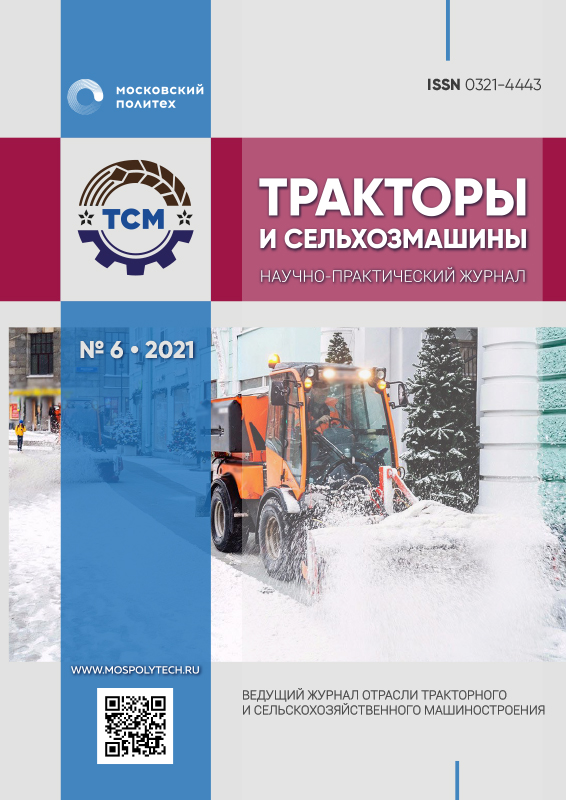Математическое моделирование движения гусеничной машины с использованием прикладного пакета RecurDyn
- Авторы: Поддубный В.И.1
-
Учреждения:
- Алтайский государственный технический университет им. И.И. Ползунова
- Выпуск: Том 88, № 6 (2021)
- Страницы: 68-75
- Раздел: Теория, конструирование, испытания
- URL: https://bakhtiniada.ru/0321-4443/article/view/95692
- DOI: https://doi.org/10.17816/0321-4443-2021-6-68-75
- ID: 95692
Цитировать
Полный текст
Аннотация
Математическое моделирование движения позволяет на стадии проектирования произвести оценку влияния конструктивных и эксплуатационных параметров гусеничных машин на их работоспособность, определить качественные и количественные показатели работы, рассмотреть вопросы управляемости. Применение программы RecurDyn с библиотекой специализированных пакетов расширения позволяет получить математическую модель машины, учитывающую ее конструкцию с задаваемой степенью детализации. С использованием пакетов расширения Professional и библиотеки Track(HM) пакета расширения Toolkit разработана модель гусеничной машины с торсионной подвеской, позволяющая проводить симуляцию стандартных маневров на различных опорных поверхностях. В пакете расширения CoLink реализована модель управления, обеспечивающая движение гусеничной машины по задаваемой траектории. За основу при разработке модели управления движением принята методика, основанная на прогнозировании положения машины через заданное время прогноза. В качестве управления принята разность скоростей забегающей и отстающей гусениц, обеспечивающая движение по задаваемой траектории. Разность скоростей ∆V определяется с использованием PID-регулирования по величинам бокового отклонения машины от задаваемой траектории и углового отклонения продольной оси машины от касательной к траектории в прогнозируемом положении. Модель управления позволяет симулировать движение машины с дифференциалом и планетарным механизмом поворота. Проведено моделирование движения по круговой траектории и маневра «змейка». Имитировалось движение гусеничной машины с планетарным механизмом поворота по твердой опорной поверхности с коэффициентом трения 0,7.
На основании результатов моделирования сделан вывод об адекватности математической модели гусеничной машины и работоспособности представленной модели управления движением. Разработанная модель позволяет симулировать различные маневры гусеничной машины для оценки устойчивости движения и управляемости, определять рациональные параметры гусеничного движителя по результатам моделирования движения при различных высотах неровностей и скоростях движения.
Полный текст
Открыть статью на сайте журналаОб авторах
Владимир Иванович Поддубный
Алтайский государственный технический университет им. И.И. Ползунова
Автор, ответственный за переписку.
Email: poddubny@list.ru
д.т.н.
Россия, БарнаулСписок литературы
- Дмитриев А.А., Чобиток В.А., Тельминов А.В. Теория и расчет нелинейных систем подрессоривания гусеничных машин. М.: Машиностроение, 1976. 207 с.
- Котиев Г.О. Прогнозирование эксплуатационных свойств систем подрессоривания военных гусеничных машин: автореф. дис. … докт. техн. наук. М., 2000, 25 с.
- Савочкин В.А., Шарипов В.М., Смирнов И.А., Шишанов С.М., Тарасова Л.И. Метод выбора рациональных параметров системы подрессоривания быстроходной гусеничной машины // Тракторы и сельхозмашины. 2015. № 3. С. 18−21.
- Ягубов В.Ф., Стрелков А.Г., Шапкин А.Н. Анализ управляемого криволинейного движения быстроходных гусеничных машин // Тракторы и сельхозмашины. 2012. № 4. С. 12−18.
- Наумов В.Н., Машков К.Ю., Пехтерев А.А., Рубцов В.И. Алгоритм предотвращения неуправляемого движения гусеничных роботов // Известия ЮФУ. Технические науки. 2017. № 1 (186). С. 29−42.
- Наказной О.А. Аналитическая зависимость критической по заносу скорости быстроходной гусеничной машины от ее колебаний // Инженерный журнал: наука и инновации. 2013. Вып. 10. URL: http://engjournal.ru/catalog/ machin/ transport/973.html
- Дьяконов В.П. Матлаб 6.5+Simulink 4/5. М.: СОЛОН-Пресс, 2002. 768 с.
- Поддубный В.И., Павлюк А.С., Поддубная М.Л. Разработка мехатронных моделей механических систем с использованием прикладного пакета CAMeL-View // Ползуновский вестник. 2013. № 4/3. С. 110−116.
- Поддубный В.И., Трехтлер А., Йекер К.П., Харченко Е., Варкентин А. Моделирование активной подвески для автомобиля повышенной проходимости и оценка возможности ее использования для снижения нагрузки на колесо с поврежденной шиной // Мехатроника автоматизация, управление. 2013. № 9. C. 47−50.
- Поддубный В.И., Поддубная М.Л. Разработка математических моделей механических систем с использованием прикладного пакета RecurDyn // Ползуновский вестник. 2015. № 1. С. 57−62.
- Коростелев С.А., Нечаев К.С., Бокин Д.П. Влияние режимов нагружения на механические характеристики материала резиновых элементов РМШ гусеничного движителя // Вестник Алтайского государственного аграрного университета. 2009. № 1 (51). С. 46−52.
- Коростелев С.А., Целищев В.А., Каширский Д.Ю. Экспериментальное определение характеристик резиновых элементов РМШ гусеничного движителя // Ползуновский вестник. 2012. № 1/1. С. 146−150.
- Сергеев Л.В. Теория танка. М.: Издание академии бронетанковых войск, 1973. 495 с.
- Поддубный В.И., Трехтлер А., Варкентин А., Крюгер М. Механико-математическая модель гусеничной машины для разработки инновационного движителя и системы подрессоривания // Вестник машиностроения. 2017. № 3. С. 46−50.
- Универсальный механизм 7.0. Моделирование динамики гусеничных машин. Руководство пользователя. 2012. URL: http://www.universalmechanism.com/download/70/rus/18_um_caterpillar.pdf (дата обращения 30.03.2020).
Дополнительные файлы
















